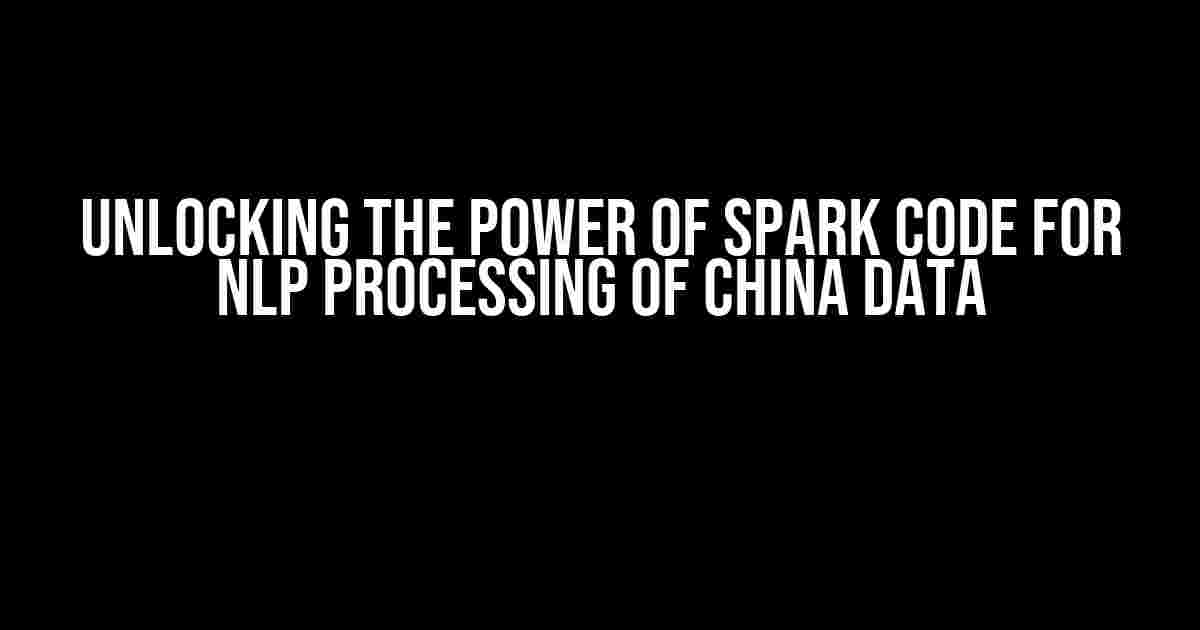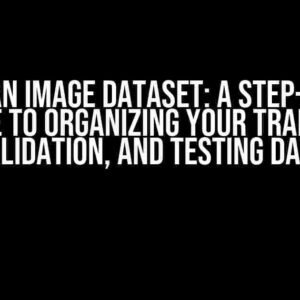As the world’s second-largest economy, China generates an immense amount of data every day. Natural Language Processing (NLP) has become a crucial tool for businesses and organizations to tap into this treasure trove of information. However, processing China data requires a deep understanding of the language, culture, and nuances of the region. In this article, we’ll delve into the world of Spark code for NLP processing of China data, providing you with a comprehensive guide to get started.
Why Spark Code for NLP Processing?
Before we dive into the nitty-gritty of Spark code, let’s explore why it’s the ideal choice for NLP processing of China data:
- Scalability**: Spark is designed to handle massive datasets, making it perfect for processing large volumes of China data.
- Speed**: Spark’s in-memory processing capabilities ensure fast execution times, even for complex NLP tasks.
- Flexibility**: Spark supports a wide range of programming languages, including Java, Python, and Scala, making it easy to integrate with your existing workflow.
- Cost-effective**: Spark is an open-source framework, reducing costs associated with proprietary software.
Setting Up Your Spark Environment
Before you begin writing Spark code, you’ll need to set up your environment:
- Install Spark**: Download and install Spark from the official Apache Spark website. Make sure to select the correct version and package type (e.g., Spark 3.0.0 with Hadoop 2.7).
- Install Java**: Spark requires Java 8 or later. Download and install the correct version from the Oracle website.
- Install Python or Scala**: Choose your preferred programming language for Spark development. Install Python 3.x or Scala 2.12.x, depending on your choice.
- Set up your IDE**: Install an Integrated Development Environment (IDE) like Eclipse, IntelliJ, or PyCharm, which supports Spark development.
Preprocessing China Data
Before applying NLP techniques, you need to preprocess your China data:
Text Preprocessing
Follow these steps to preprocess your China data:
from pyspark.ml.feature import Tokenizer, StopWordsRemover
# Load your data into a Spark DataFrame
df = spark.read.csv("china_data.csv", header=True, inferSchema=True)
# Tokenize the text data
tokenizer = Tokenizer(inputCol="text", outputCol="words")
tokenized_df = tokenizer.transform(df)
# Remove stop words
stop_words = StopWordsRemover(inputCol="words", outputCol="filtered_words")
filtered_df = stop_words.transform(tokenized_df)
# Remove special characters and punctuation
filtered_df = filtered_df.selectExpr("filtered_words", " Lower(regexp_replace(filtered_words, '[^a-zA-Z]', '')) as cleaned_words")
Handling Chinese Characters
Chinese characters require special handling due to their complex nature:
from pyspark.ml.feature import VectorAssembler
# Convert Chinese characters to Unicode
filtered_df = filtered_df.selectExpr("cleaned_words", "concat_ws(', ', array(*split(cleaned_words, ','))) as unicode_words")
# Assemble features into a vector
assembler = VectorAssembler(inputCols=["unicode_words"], outputCol="features")
assembled_df = assembler.transform(filtered_df)
NLP Processing with Spark
Now that your data is preprocessed, it’s time to apply NLP techniques using Spark:
Sentiment Analysis
Use Spark’s MLlib library for sentiment analysis:
from pyspark.ml.classification import NaiveBayes
# Train a Naive Bayes model
nb_model = NaiveBayes(featuresCol="features", labelCol="label")
trained_model = nb_model.fit(assembled_df)
# Make predictions
predictions = trained_model.transform(assembled_df)
Topic Modeling
Perform topic modeling using Spark’s LDA (Latent Dirichlet Allocation) algorithm:
from pyspark.ml.clustering import LDA
# Train an LDA model
lda_model = LDA(featuresCol="features", k=5)
trained_model = lda_model.fit(assembled_df)
# Get topic distributions
topics = trained_model.describeTopics(k=5)
Visualizing Results
Use Spark’s built-in visualization tools or external libraries like Matplotlib and Seaborn to visualize your results:
import matplotlib.pyplot as plt
import seaborn as sns
# Plot sentiment analysis results
sns.countplot(x="label", data=predictions.toPandas())
plt.title("Sentiment Analysis Results")
plt.show()
# Plot topic modeling results
sns.barplot(x="topic", y="weight", data=topics.toPandas())
plt.title("Topic Modeling Results")
plt.show()
| Technique | Description |
|---|---|
| Sentiment Analysis | Classifies text data as positive, negative, or neutral |
| Topic Modeling | Identifies underlying topics in text data |
Conclusion
In this article, we’ve covered the basics of Spark code for NLP processing of China data. By following these steps, you’ll be able to unlock the power of Spark for your NLP projects. Remember to experiment with different preprocessing techniques, NLP algorithms, and visualization tools to optimize your results.
As you continue to explore the world of Spark and NLP, keep in mind the following:
- Data quality matters**: Ensure your China data is accurate, complete, and relevant to your project.
- Tune hyperparameters**: Experiment with different hyperparameters to optimize your NLP models.
- Stay up-to-date**: Spark and NLP are constantly evolving, so stay informed about the latest developments and updates.
Happy coding, and happy NLP-ing!
Note: This article is for educational purposes only and does not contain any proprietary or confidential information.
Frequently Asked Question
Get ready to unleash the power of Spark code for NLP processing on China data! Here are some frequently asked questions to get you started:
What is the best way to preprocess Chinese text data for NLP processing using Spark?
When working with Chinese text data, it’s essential to perform proper preprocessing to ensure accurate NLP analysis. In Spark, you can use the `spark-nlp` library, which provides a range of preprocessing tools, such as tokenization, stopword removal, and word embedding. Additionally, consider using Chinese-specific tokenization tools, like `jena` or `stanza`, to handle Chinese characters accurately.
How do I handle Chinese character encoding issues in Spark NLP processing?
To avoid encoding issues, make sure to specify the correct character encoding when reading Chinese text data into Spark. You can do this by setting the `encoding` parameter to `UTF-8` or `GB18030`, which are commonly used encodings for Chinese characters. Additionally, consider using Spark’s `unpack` function to convert Unicode code points to Chinese characters.
What is the role of word embeddings in NLP processing for Chinese data using Spark?
Word embeddings, such as Word2Vec or GloVe, are essential for NLP processing in Spark, as they enable the capture of semantic relationships between Chinese words. By using pre-trained word embeddings, like `word2vec-zh` or `GloVe-zh`, you can improve the accuracy of NLP models, such as text classification, sentiment analysis, and topic modeling.
How do I integrate Chinese NLP libraries with Spark for more advanced processing?
To leverage the capabilities of Chinese NLP libraries, like `jieba`, `NLTK`, or `spaCy`, with Spark, you can use Spark’s `udf` (User-Defined Function) feature to wrap these libraries. This allows you to integrate their functionality with Spark DataFrames and DataSets, enabling more advanced NLP processing, such as part-of-speech tagging, named entity recognition, and dependency parsing.
What are some best practices for optimizing Spark NLP processing for large-scale Chinese datasets?
When working with large-scale Chinese datasets, it’s crucial to optimize Spark NLP processing for performance. Some best practices include: using Spark’s `cache` function to store intermediate results, leveraging distributed processing with `spark.executor.cores` and `spark.executor.memory`, and tuning Spark configurations, such as `spark.sql.shuffle.partitions` and `spark.driver.maxResultSize`. Additionally, consider using Spark’s `DataFrames` instead of `RDDs` for improved performance.
Note: The above FAQ is created using HTML and schema.org markup to provide a structured and accessible format for search engines and screen readers.



